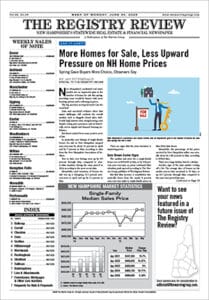
With the pandemic-era boom in lending over, these are the banks, credit unions and mortgage companies bucking the trend. iStock illustration
With the pandemic-era boom in lending over, many of the financial institutions that operate in New Hampshire are facing leaner times.
For the first time, The Registry Review’s annual ranking of the state’s 50 fastest-growing lenders has included lenders whose loan volumes are shrinking more slowly than their peers.
The Fast 50, compiled from data collected by The Warren Group, publisher of The Registry Review, reveals the 50 fastest-growing lenders in Massachusetts for the first six months of the year, compared to the same period a year ago.
To qualify, residential mortgage lenders had to have made a minimum of five loans in both the first half of 2022 and the first half of 2023 worth a combined total of $5 million in each period. Commercial real estate lenders faced similar restrictions: at least $1 million in loan volume and a minimum of three loans in each period.
Of the 136 banks, credit unions and mortgage companies that met this standard for residential lending, 114 saw zero or negative growth between the two periods – 102 of which saw at least a 20 percent downturn in loan volumes.
And among the 55 lenders that met this standard for commercial lending, 38 saw CRE loan volume shrinkage, and 35 watched their commercial real estate volumes drop by at least 33 percent.
Who Were New Hampshire’s Fastest-Growing Lenders? See Our Rankings!
Interest Rates a Driver
What’s new this year? Bankers interviewed for this story say part of it comes down to higher interest rates that have made borrowing for any purpose, even one as profitable as a new apartment building in this housing-starved state, worth second-guessing.
“The funding costs on the deposit end have gone up so dramatically,” said John Swedberg, senior vice president and senior commercial lending officer at Meredith Village Savings Bank. “Every bank has to get a reasonable spread to cover their overhead and make even a small profit. But as the cost of funds to banks have gone up, we still have to get a reasonable return, which means a higher rate on those commercial loans.”
Meredith Village Savings Bank was one of the few lenders who turned in commercial real estate loan volume growth, ranking as the 12th-fastest-growing lender in the state.
As lenders had to watch the Federal Reserve’s successive interest rate increases work their way through their books and term sheets this spring, it had practical effects on prospective commercial real estate borrowers.
“When you’re doing your pro forma and you calculate in an interest carry [cost] for your debt level, you might have used a rate based on the last loan you got, or maybe you bumped it up a little,” Swedberg said. “Then you realize it’s suddenly going to be a lot more than that, and it has impacts on your return on investment and more which makes you take a breath as an investor.”
In this environment, he said, the owner-operator firms that typically take out commercial real estate loans from MVSB need to justify higher debt costs with higher profit margins – not necessarily an easy thing to find in this economic environment.
Total Market Shrank
That skittishness can be seen in statewide data, too. According to data from The Warren Group, the total volume of commercial real estate mortgages of all types originated in the first two quarters of this year plummeted to $1.67 billion, down from $4.91 billion in the same period in 2022, $5.86 billion in 2021.
That’s the lowest it’s been since 2016 when only $992.17 million in CRE loans were originated in the first half, and only slightly above the $1.28 billion per year the state averaged during the first half of each year from 2010 to 2019.
The residential side of the ledger paints a slightly better picture. Banks, credit unions and mortgage companies issued $3.27 billion worth of residential loans of all types in the first half of 2023, down from $7.27 in the first half of 2022.
But this year’s tally is substantially below the $4.24 billion first-half average before the pandemic. Fewer residential properties traded hands in the first half this year than any time since at least 2010, according to The Warren Group, even as the statewide median sale price for these homes continued to scrape the sky each month.
When will it end? Top Federal Reserve officials have repeatedly said in recent weeks that they don’t expect to lower interest rates any time soon as they keep a watchful eye on inflation rates that, though declining, are still elevated.
“In my view, this phase of our [monetary] policy cycle requires patience, and holistic data assessment, while we stay the course. I expect we’ll need to hold rates at restrictive levels for some time. And while we may be near, or even at, the peak for policy rates, further tightening could be warranted, depending on the incoming data,” Federal Reserve Bank of Boston President Susan Collins, who sits on the Fed’s interest rate-setting committee, said during a Sept. 6 speech.
That cloudiness on exactly where the state and national economies are headed appears to be the bottom line, and is keeping many borrowers from seeking out debt, MVSB’s Swedborg said.
“There’s still a lot of uncertainty out there. Caution is generally the byword,” he said.

